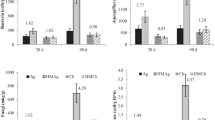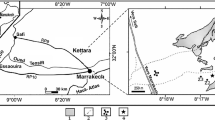Abstract
Mediterranean climate characteristics and carbonate are key factors governing soil heavy-metal accumulation, and low organic matter (OM) content could limit the ability of microbial populations to cope with resulting stress. We studied the effects of metal contamination on a combination of biological parameters in soils having these characteristics. With this aim, soils were spiked with a mixture of cadmium, copper, lead, and zinc, at the two limit values proposed by current European legislation, and incubated for ≤12 months. Then we measured biochemical (phosphatase, urease, β-galactosidase, arylsulfatase, and dehydrogenase activities) and microbial (fungal and bacterial DNA concentration by quantitative polymerase chain reaction) parameters. All of the enzyme activities were strongly affected by metal contamination and showed the following inhibition sequence: phosphatase (30–64 %) < arylsulfatase (38–97 %) ≤ urease (1–100 %) ≤ β-galactosidase (30–100 %) < dehydrogenase (69–100 %). The high variability among soils was attributed to the different proportion of fine mineral fraction, OM, crystalline iron oxides, and divalent cations in soil solution. The decrease of fungal DNA concentration in metal-spiked soils was negligible, whereas the decrease of bacterial DNA was ~1–54 % at the lowest level and 2–69 % at the highest level of contamination. The lowest bacterial DNA decrease occurred in soils with the highest OM, clay, and carbonate contents. Finally, regarding the strong inhibition of the biological parameters measured and the alteration of the fungal/bacterial DNA ratio, we provide strong evidence that disturbance on the system, even within the limiting values of contamination proposed by the current European Directive, could alter key soil processes. These limiting values should be established according to soil characteristics and/or revised when contamination is produced by a mixture of heavy metals.




Similar content being viewed by others
References
Acosta-Martínez V, Zobeck TM, Gill TE, Kennedy AC (2003) Enzyme activities and microbial community structure in semiarid agricultural soils. Biol Fertil Soils 38:216–227
Anderson IC, Parkin PI, Campbell CD (2008) DNA- and RNA-derived assessments of fungal community composition in soil amended with sewage sludge rich in cadmium, copper and zinc. Soil Biol Biochem 40(9):2358–2365
Baldrian P (2003) Interactions of heavy metals with white-rot fungi. Enzyme Microb Technol 32:78–91
Bastida F, Moreno JL, Hernández T, García C (2006) Microbiological degradation index of soils in a semiarid climate. Soil Biol Biochem 38:3463–3473
Batjes NH (2000) Soil Vulnerability to Diffuse Pollution in Central and Eastern Europe SOVEUR Project (Version 1.0). Food and Agricultural Organization and International Soil Reference and Information Center
Belyaeva ON, Haynes RJ, Birukova OA (2005) Barley yield and soil microbial and enzyme activities as affected by contamination of two soils with lead, zinc or copper. Biol Fertil Soils 41:85–94
Borneman J, Martin RJ (2000) PCR primers that amplify fungal rRNA genes from environmental samples. Appl Environ Microbiol 66(10):4356–4360
Brandt KK, Frandsen RJN, Holm PE, Nybroe O (2010) Development of pollution-induced community tolerance is linked to structural and functional resilience of a soil bacterial community following a five-year field exposure to copper. Soil Biol Biochem 42:748–757
Brookes PC (1995) The use of microbial parameters in monitoring soil pollution by heavy metals. Biol Fertil Soils 19(4):269–279
Burns RG, Pukite AH, McLaren AD (1972) Concerning the location and the persistence of soil urease. Soil Sci Soc Am Proc 36:308–311
Chander K, Brookes PC (1991) Is the dehydrogenase assay invalid as a method to estimate microbial activity in copper contaminated soils? Soil Biol Biochem 23:909–915
Chander K, Dyckmans J (2001) Different sources of heavy metals and their long-term effects on soil microbial properties. Biol Fertil Soils 34:241–247
de Boer W, Folman LB, Summerbell RC, Boddy L (2005) Living in a fungal world: impact of fungi on soil bacterial niche development. FEMS Microbiol Rev 29(4):795–811
Dick RP, Breakwell DP, Turco RF (1996) Soil enzyme activities and biodiversity measurements as integrative microbiological indicators. In: Doran JW, Jones AJ (eds) Methods for assessing soil quality. Special publication No. 49. Soil Science Society America, Madison, p 247–271
Directive 86/278/EEC of 12 June 1986 on the protection of the environment, and in particular of the soil, when sewage sludge is used in agriculture
Food and Agricultural Organization (2006) World reference base for soil resources. A framework for international classification, correlation and communication. FAO, Roma
Gadd GM (2007) Geomycology: biogeochemical transformations of rocks, minerals, metals and radionuclides by fungi, bioweathering and bioremediation. Mycol Res 111:3–49
Gangneux C, Akpa-Vinceslas M, Sauvage H, Desaire S, Houot S, Laval K (2011) Fungal, bacterial and plant dsDNA contributions to soil total DNA extracted from silty soils under different farming practices: relationships with chloroform-labile carbon. Soil Biol Biochem 43:431–437
Gianfreda L, Rao MA, Violante A (1995) Formation and activity of urease-tannate complexes affected by aluminium, iron, and manganese. Soil Sci Soc Am J 59(3):805–810
Hinojosa MB, Carreira JA, García-Ruíz R, Dick RP (2004) Soil moisture pre-treatment effects on enzyme activities as indicators of heavy metal-contaminated and reclaimed soils. Soil Biol Biochem 36:1559–1568
Instituto Geológico y Minero de España (1990) Mapa geológico de España nº 535. Escala 1:50.000 (Algete), Madrid, Spain
International Soil Reference and Information Center (2002) Procedures for soil analysis, 3rd edn. ISRIC, Wageningen
Jiménez Ballesta R, Conde Bueno P, Martín Rubí JA, García Giménez R (2010) Pedo-geochemical baseline content levels and soil quality reference values of trace elements in soils from the Mediterranean (Castilla La Mancha, Spain). Eur J Geosci 2(4):441–454
Kızılkaya R, Aşkın T, Bayraklı B, Sağlam M (2004) Microbiological characteristics of soils contaminated with heavy metals. Eur J Soil Biol 40:95–102
Krull EJ, Baldock J, Skjemstad J (2001) Soil texture effects on decomposition and soil carbon storage. Net Ecosystem Exchange CRC Workshop Proceedings, p 103–110
Kunito T, Oyaizu H, Matsumoto S (1998) Ecology of soil heavy metal-resistant bacteria and perspective of bioremediation of heavy metal-contaminated soils. Recent Res Dev Agric Biol Chem 2:185–206
Kunito T, Senoo K, Saeki K, Oyaizu H, Matsumoto S (1999) Usefulness of the sensitivity-resistance index to estimate the toxicity of copper on bacteria in copper-contaminated soils. Ecotoxicol Environ Saf 44:182–189
Lafuente AL, González C, Quintana JR, Vázquez A, Romero A (2008) Mobility of heavy metals in poorly developed carbonate soils in the Mediterranean region. Geoderma 145:238–244
Lindsay WL, Norvell WA (1978) Development of a DTPA soil test for zinc, iron, manganese and copper. Soil Sci Soc Am J 42:421–428
Marchesi JR, Sato T, Weightman AJ, Martin TA, Fry JC, Hiom SJ et al (1998) Design and evaluation of useful bacterium-specific PCR primers that amplify genes coding for Bacterial 16S rRNA. Appl Environ Microbiol 64(2):795–799
Martínez-Iñigo MJ, Pérez-Sanz A, Ortiz I, Alonso J, Alarcón R, García P et al (2009) Bulk soil and rhizosphere bacterial community PCR–DGGE profiles and b-galactosidase activity as indicators of biological quality in soils contaminated by heavy metals and cultivated with Silene vulgaris (Moench) Garcke. Chemosphere 75:1376–1381
Marzadori C, Francioso O, Ciavatta C, Gessa C (2000) Influence of the content of heavy metals and molecular weight of humic acids fractions on the activity and stability of urease. Soil Biol Biochem 32:1893–1898
McLaughlin MJ (2001) Aging of metals in soils changes bioavailability. Environ Risk Assess 4:1–6
Micó C, Recatalá L, Peris M, Sánchez J (2006) Assessing heavy metal sources in agricultural soils of an European Mediterranean area by multivariate analysis. Chemosphere 65:863–872
Moreno Merino L (1998) Estudio de la influencia del suelo sobre la composición de las aguas subterráneas a través de la solución del suelo. Modelo en Fluvisoles calcáricos. Doctoral thesis, Universidad Complutense de Madrid, Madrid
Moreno JL, Bastida F, Ros M, Hernández T, García C (2009) Soil organic carbon buffers heavy metal contamination on semiarid soils: effects of different metal threshold levels on soil microbial activity. Eur J Soil Biol 45:220–228
Muyzer G, de Waal EC, Uitierlinden AG (1993) Profiling of complex microbial populations by denaturing gradient gel electrophoresis analysis of polymerase chain reaction-amplified genes coding for 16S rRNA. Appl Environ Microbiol 59:695–700
Nannipieri P, Greco S, Ceccanti B (1990) Ecological significance of the biological activity in soil. In: Bollag J-M, Stotzky G (eds) Soil biochemistry, vol 6. Marcel Dekker, New York, pp 293–355
Obbard JP (2001) Ecotoxicological assessment of heavy metals in sewage sludge amended soils. Appl Geochem 16:1405–1411
Olander LP, Vitousek PM (2000) Regulation of soil phospahatase and chitinase activity by N and P availability. Biogeochemistry 49:175–190
Pascual JA, Moreno JL, Hernández T, García C (2002) Persistence of immobilised and total urease and phosphatase activities in a soil amended with organic wastes. Bioresour Technol 82:73–78
Peris M, Micó C, Recatalá L, Sánchez R, Sánchez J (2007) Heavy metal contents in horticultural crops of a representative area of the European Mediterranean region. Sci Total Environ 378:42–48
Piotrowska A, Iamarino G, Rao MA, Gianfreda L (2006) Short-term effects of olive mill waste water (OMW) on chemical and biochemical properties of a semiarid Mediterranean soil. Soil Biol Biochem 38(3):600–610
Plassard F, Winiarski T, Petit-Ramel M (2000) Retention and distribution of three heavy metals in a carbonated soil: comparison between batch and unsaturated column studies. J Contam Hydrol 42:99–111
Renella G, Ortigoza ALR, Landi L, Nannipieri P (2003) Additive effects of copper and zinc on cadmium toxicity on phosphatase activities and ATP content of soil as estimated by the ecological dose (ED50). Soil Biol Biochem 35:1203–1210
Renella G, Landi L, Nannipieri P (2004) Degradation of low molecular weight organic acids complexed with heavy metals in soil. Geoderma 122:311–315
Renella G, Mench M, Landi L, Nannipieri P (2005) Microbial activity and hydrolase synthesis in long-term Cd-contaminated soils. Soil Biol Biochem 37:133–139
Rivas-Martínez S (1987) Memoria del mapa de series de vegetación de España. 1:400.000. ICONA. Madrid, Spain
Roca-Perez L, Gil C, Cervera ML, Gonzálvez A, Ramos-Miras J, Pons V, Bech J, Boluda R (2010) Selenium and heavy metals content in some Mediterranean soils. J Geochem Explor 107:110–116
Rousk J, Bååth E, Brookes PC, Lauber CL, Lozupone C, Caporaso JG et al (2010) Soil bacterial and fungal communities across a pH gradient in an arable soil. ISEM J 4(10):1340–1351
Rovira P, Vallejo VR (2000) Evaluating thermal and acid hydrolysis methods as indicators of soil organic matter quality. Commun Soil Sci Plant Anal 31:81–100
Sayyad G, Afyuni M, Mousavi SF, Abbaspour KC, Richards BK, Schulin R (2010) Transport of Cd, Cu, Pb and Zn in a calcareous soil under wheat and safflower cultivation—a column study. Geoderma 154:311–320
Schaefer R (1963) Dehydrogenase activity as a measurement of the global biological activity of soil. Ann Inst Pasteur 105:326–331
Sinsabaugh RL, Reynolds H, Long TM (2000) Rapid assay for amidohydrolase (urease) activity in environmental samples. Soil Biol Biochem 32(14):2095–2097
Società Italiana della Scienza del Suolo (1985) Metodi Normalizzati di Analisi del Suolo. Edagricole, Bologna
Speir TW, Ross DJ, Feltham CW, Orchard VA, Yeates G (1992) Assessment of the feasibility of using CCA (copper, chromium and arsenic)-treated and boric acid-treated sawdust as soil amendments. II. Soil biochemical and biological properties. Plant Soil 142:249–258
Tabatabai MA (1994) Soil enzymes. In: Weaver RW, Angle JS, Bottomley PS (eds) Methods of soil analysis: Microbial and biochemical properties. Part 2. American Society of Agronomy, Madison, p 775–833
Tabatabai MA, Bremner JM (1970) Arylsulfatase activity in soils. Soil Soc Sci Am Proc 34:225–229
Trasar-Cepeda C, Leirós MC, Seoane S, Gil-Sotres F (2008) Biochemical properties of soils under crop rotation. Appl Soil Ecol 39:133–143
Vig K, Megharaj M, Sethunathan N, Naidu R (2003) Bioavailability and toxicity of cadmium to microorganisms and their activities in soil: a review. Adv Environ Res 8:121–135
Acknowledgments
This work was supported by the PESSAC department (INRA), Universidad Complutense de Madrid, and the Community of Madrid through Grant No. GR58/08, Research Team 950605, and Network CARESOIL, Ref. P2009/AMB-1648. The authors gratefully acknowledge the help of Christelle Marrauld (PESSAC, INRA) in biochemical analyses as well as the comments and suggestions of the editor and the anonymous referees.
Author information
Authors and Affiliations
Corresponding author
Rights and permissions
About this article
Cite this article
de Santiago-Martín, A., Cheviron, N., Quintana, J.R. et al. Metal Contamination Disturbs Biochemical and Microbial Properties of Calcareous Agricultural Soils of the Mediterranean Area. Arch Environ Contam Toxicol 64, 388–398 (2013). https://doi.org/10.1007/s00244-012-9842-8
Received:
Accepted:
Published:
Issue Date:
DOI: https://doi.org/10.1007/s00244-012-9842-8




